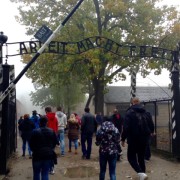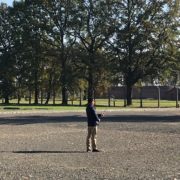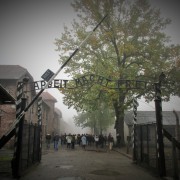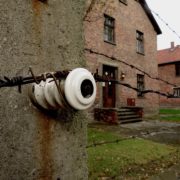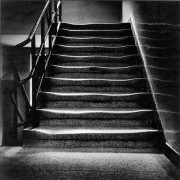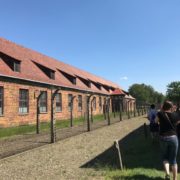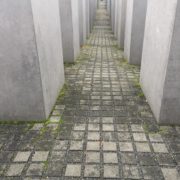Relations Between Peoples of a Troubled East Central Europe
By: Kevin Kuzniczci
From the mountains and foothills of the northwestern segment of the Czech Republic to the expansive metropolis of Berlin to the somber town of Oswiecim, the lands of east central Europe contain a vast history that, a few decades ago, experienced quite a great deal of strife. Prague and Sluknov, all within the northwestern segment of the Czech Republic, have dealt with unstable borders, prejudice directed at the Jews, and the ethnic tensions between the mainstream ethnicity (Czech culture) and the Roma; in essence, the Czech mainstream ethnicity still has a great amount of improvement to make in terms of ethnic and racial harmony. In Krakow and Oswiecim the significance of the historically Jewish neighborhood of Kazimierz (within Krakow) and the Auschwitz-Birkenau historical site in terms of Jewish culture is required to be emphasized in substantial detail; the contributions these sites not only express the dramatic history of Galicia but they also paint a portrait about how humanity has the potential to swing to moral extreme. The German cities of Berlin and Dresden illustrate two distinct ways how people cope with national trauma and titanic levels of shame, with the former altering itself as a metropolis of fluidity and the latter as a city that has lacked the same level of discourse about the past.

A view of the small town of Sluknov, in the Czech Republic, that houses a significant number of Roma.
When our group began our first academic tour in Prague at the Museum of Anti-Semitism from Czech Lands, learning about the harsh conditions of the refugee camps and the xenophobia amongst the Czech people made me realize just how dangerous nationalism can be when left untamed; when considering how volatile and unstable the borders within the Austrian-Hungarian empire (especially Galicia and Moravia) were, the realization came to me that none of this anti-Semitism would have occurred if people just viewed these “eastern” Jews (as a part of the Orient) just as Czech as any other Czech citizen. I was glad to learn that, by the nineties, the Jewish people residing within the borders of the Czech Republic were accepted by the mainstream ethnicity not simply because of what happened in the Holocaust, but by the fact that the public memory of such a horrific event was discussed en masse within the Communist years without being too restricted by the government; it was also depressing to grasp the amount of turmoil the Roma went through in the 20th century within the former Czechoslovakia, and even today, as we were told by the people in the Institute of Ethnology.
In fact, once we arrived in the foothills of the region once known as Sudetenland in the small town of Sluknov, learning about how much discrimination and prejudice that is directed against the Roma was so disturbing for me, as an American, since such overt acts of discrimination would be frowned upon back in the United States; in addition to being informed about the 2011 race riots, I have realized the importance of breaking down stereotypes (such as Europeans being more progressive than Americans) in order to judge people as unassuming as possible. All in all, our time in the Czech Republic taught me the dangers of living in a homogenous society and how people should further understand what divides us (ethnic differences) and unites us (they all suffered under the Communist era as Czechoslovakians).
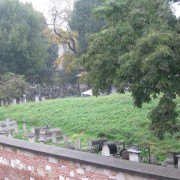
The Jewish Cemetery of Kazimierz, in Krakow, Poland, where Jews of the once vibrant community were laid to rest.
Our group’s first stop in Krakow was the historically Jewish part of Krakow, known as Kazimierz, and at this first stop we discovered how much the Jewish populace of the former Polish kingdom had influenced Poland as a whole. Not only was the Polish kingdom a domain for tolerance for the Jews, even when they were evicted to the town to Kazimierz in the early 1400s after a fire was blamed on the Jews, but it also served as a sort of “Jerusalem of the North” for those escaping persecution; as someone with Polish roots this realization invoked a sense of pride within me and also expanded my perception of how the middle ages of Europe were not simply times of backwardness, as this information gives us a sense that Jews were receiving “freedom through living”.
The next day we arrived at Auschwitz-Birkenau, learning that the only reason there were survivors was simply because it was a lottery in terms of life and death; our tour guide explained to us that there was only “freedom through death” to those who could not win this “lottery”, which made me wonder about what went through the minds of the Nazis stationed here and how they convinced themselves to treat starving, sick prisoners as animals (through demonization of the “other”). Examining all the plundered items, the artistic depictions of suffering, and the tools for mass destruction made me consider the difference between tolerance and hatred like a swing throughout time in Galicia (and other parts of the world); I felt that this horrific evidence was verification that, no matter how much change goes on in this world, it is vital to utilize everything in our power, as individuals, to divert humanity from brutal paths as much as we can.
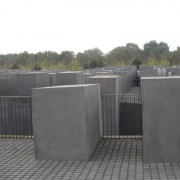
The Memorial of the Murdered Jews of Europe in Berlin. This memorial explains the hardships the Jews went through from 1933 to 1945 as well as the intricacies of the murderous Nazi system.

The Jorge Momondai Memorial in Dresden, Germany, dedicated to the victim of reunified Germany’s first murder committed because of xenophobia. Jorge was a Mozambique worker, sent during the Communist era, who was beaten by neo-Nazis.
When recalling about my experiences in Berlin and Dresden, the factor that makes the two cities contrast from one another is their response to the changes that happened between 1945 and this present day. In Dresden there are quite a lot of buildings from the pre-1945 period that are being rebuilt (if not already rebuilt) and there are the annual commemoration events on every February 13th since reunification; in the latter case there are neo-Nazi demonstrators who “lament the excessive destruction” of Dresden, as a suggestion that some within the city still gauge themselves as innocent victims of war rather than a target supplying an aggressive power. In Berlin, however, I immediately regarded the city as modern, capable of moving on past the horrors of before, and willing to discuss about the mistakes it made in the past (instead of seeing itself with a personification of flawlessness called nationalism); the Memorial for the Murdered Jews and the Stasi prison museum are evidence to the city’s fluidity.
In contrast Dresden still seems to have contention confronting its history, as evident in its xenophobia (thinking of the Jorge Gomondai Memorial), but that is not to state that no efforts have been made to admit their mistakes because of the denial of a number of people (reflecting on the Military History Museum).
When reflecting my experiences and thoughts in Galicia, the Czech Republic, and eastern Germany, my composite theme for these areas involve the fluidity of life and strife throughout time. In the Czech Republic, while the Jews have dealt with extreme hate and extreme admiration all within the span of one century in this nation, the constant fact that the Czech Republic is a homogenous society tends to create complications with those who do not conform to the mainstream (as evident in their treatment of the Roma); the only way to avert themselves from this dangerous road, in my opinion, is to educate people the importance of being unassuming and open-minded to difference (thus making mainstream society more fluid). When visiting Kazimierz and Auschwitz-Birkenau, the fluidity of people’s tolerance for “the Orient” was clearly demonstrated as something that should be controlled carefully as to prevent as much strife as possible; the alarming, dramatic sense from being at home to the realization of “freedom through death” is not an evil I would put my worst enemy through. Berlin and Dresden, when explaining the process of coping with the past, serves as guidelines as to how one should deal with realizing oneself as the perpetrator of horrible acts; when people admit their mistakes earnestly, discuss about it, and try to move on (instead of finding excuses to victimize themselves), they can keep themselves the same way throughout history rather than be forgotten as a fluid, temporary factor of history.


